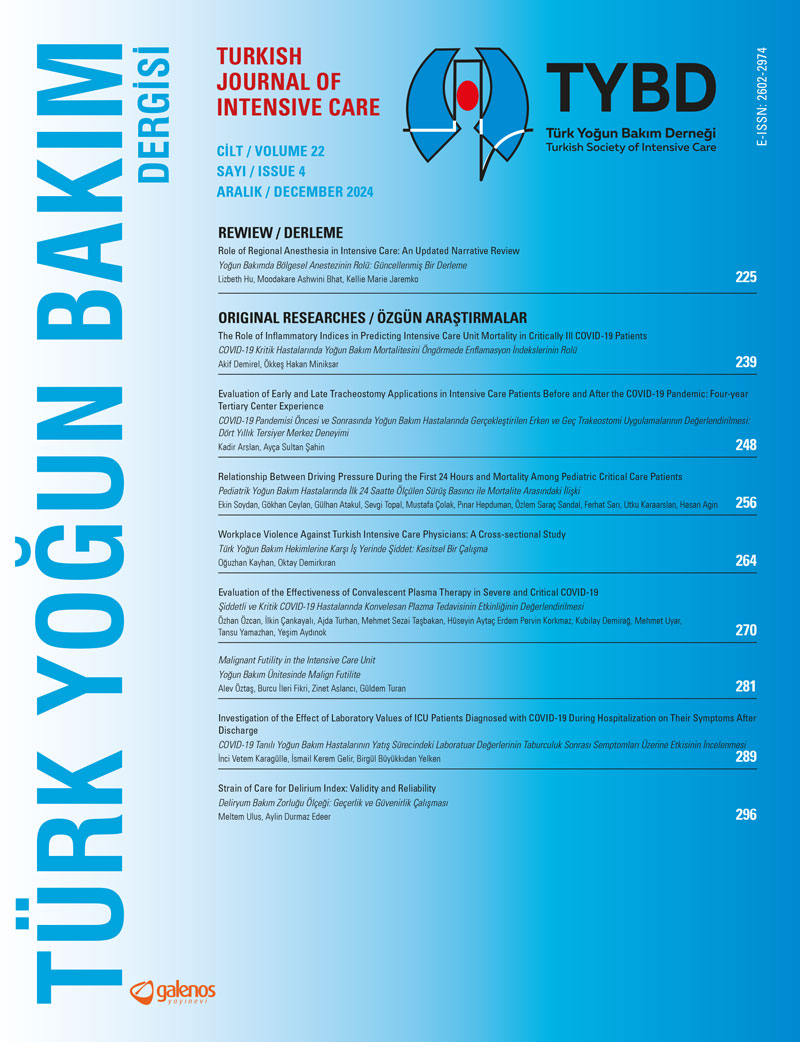Öz
Amaç
Solunum yetmezliği, çocuk yoğun bakım ünitesi hastalarında en sık ölüm nedenlerinden biridir. Yetişkin ve az sayıda pediatrik çalışmada akut solunum distresi sendromu (ARDS) hastalarında sürüş baskısı ile mortaliteyi ilişkilendirmiştir, ancak ARDS'si olmayan hastalarda sürüş basıncı ile mortalite arasındaki ilişkiyi gösteren çalışmalar tutarsız ve sınırlıdır. Bu çalışmada solunum yetmezliği nedeniyle mekanik ventilasyon desteği alan pediatrik ARDS (pARDS) ve non-pARDS tanılı pediatrik hastalarda sürüş basıncının mortalite ile ilişkisinin belirlenmesi amaçlandı.
Gereç ve Yöntem
Öngörülen ventilasyon süresi 24 saatten fazla mekanik ventilasyon uygulanan hastalar kaydedildi. pARDS ve non-PARDS gruplarındaki hastaların sürüş basıncı ve diğer ventilatör parametreleri 30 günlük mortaliteleri ile karşılaştırıldı.
Bulgular
Çalışmamıza toplam 116 çocuk dahil edildi. Otuz dört hasta pARDS grubunda sınıflandırılırken, 82 hasta PARDS dışı gruptaydı. Tüm hastaların mekanik ventilasyonun ilk günü parametreleri [∆P (p<0,001), PIP (p<0,001), Pplat (p<0,001), Pmean (p=0,008), Cstat (p<0,001), Cstat/vücut ağırlığı (p<0,001), FiO2 (p=0,001)] hastane mortalitesi ile ilişkili bulunmuştur. Tek değişkenli analizde mortalite ile ilişkilendirilen sürüş basıncı ve diğer ventilatör parametreleri, lojistik regresyon analizi ile ayrıca değerlendirildi ve sürüş basıncı, mortalite ile en ilişkili ventilatör parametresi olarak belirlendi [olasılık oranı (OR)=1,51, %95 güven aralığı (GA) 1,24-1,82, p≤0,001]. pARDS ve pARDS olmayan hastalarda ΔP ile mortalite arasındaki ilişkiyi bağımsız olarak değerlendirdik ve ΔP'nin hem PARDS hastalarında (OR=1,59, %95 GA 1,06-2,36, p<0,022) hem de non-PARDS hastalarda mortalite ile ilişkili olduğunu bulduk (OR=1,47, %95 GA 1,09-1,98, p<0,010). Tüm hasta grupları için 14,5 cm H2O’luk bir sürüş basıncı kesme değeri belirledik.
Sonuç
Sürüş basıncı, mekanik olarak ventile edilen hem pARDS hem de pARDS olmayan hastalarda artan mortalite riski ile anlamlı şekilde ilişkiliydi.
Anahtar Kelimeler: Sürüş basıncı, pediatrik yoğun bakım ünitesi, mortalite, pediatrik akut solunum sıkıntısı sendromu
Referanslar
- Ferguson ND, Fan E, Camporota L, Antonelli M, Anzueto A, Beale R, et al. The Berlin definition of ARDS: an expanded rationale, justification, and supplementary material. Intensive Care Med. 2012;38:1573-82. Erratum in: Intensive Care Med. 2012;38:1731-2.
- Santschi M, Jouvet P, Leclerc F, Gauvin F, Newth CJ, Carroll CL, et al. Acute lung injury in children: therapeutic practice and feasibility of international clinical trials. Pediatr Crit Care Med. 2010;11:681-9.
- Pediatric Acute Lung Injury Consensus Conference Group. Pediatric acute respiratory distress syndrome: consensus recommendations from the Pediatric Acute Lung Injury Consensus Conference. Pediatr Crit Care Med. 2015;16:428-39.
- Kneyber MCJ, de Luca D, Calderini E, Jarreau PH, Javouhey E, Lopez-Herce J, et al. Recommendations for mechanical ventilation of critically ill children from the Paediatric Mechanical Ventilation Consensus Conference (PEMVECC). Intensive Care Med. 2017;43:1764-80.
- Acute Respiratory Distress Syndrome Network; Brower RG, Matthay MA, Morris A, Schoenfeld D, Thompson BT, et al. Ventilation with lower tidal volumes as compared with traditional tidal volumes for acute lung injury and the acute respiratory distress syndrome. N Engl J Med. 2000;342:1301-8.
- Slutsky AS, Ranieri VM. Ventilator-induced lung injury. N Engl J Med. 2013;369:2126-36.
- Guo L, Xie J, Huang Y, Pan C, Yang Y, Qiu H, et al. Higher PEEP improves outcomes in ARDS patients with clinically objective positive oxygenation response to PEEP: a systematic review and meta-analysis. BMC Anesthesiol. 2018;18:172.
- Khemani RG, Conti D, Alonzo TA, Bart RD 3rd, Newth CJ. Effect of tidal volume in children with acute hypoxemic respiratory failure. Intensive Care Med. 2009;35:1428-37.
- Briel M, Meade M, Mercat A, Brower RG, Talmor D, Walter SD, et al. Higher vs lower positive end-expiratory pressure in patients with acute lung injury and acute respiratory distress syndrome: systematic review and meta-analysis. JAMA. 2010;303:865-73.
- Amato MB, Meade MO, Slutsky AS, Brochard L, Costa EL, Schoenfeld DA, et al. Driving pressure and survival in the acute respiratory distress syndrome. N Engl J Med. 2015;372:747-55.
- Aoyama H, Pettenuzzo T, Aoyama K, Pinto R, Englesakis M, Fan E. Association of Driving Pressure with Mortality among Ventilated Patients with Acute Respiratory Distress Syndrome: a systematic review and meta-analysis. Crit Care Med. 2018;46:300-6.
- Chen Z, Wei X, Liu G, Tai Q, Zheng D, Xie W, et al. Higher vs. Lower DP for Ventilated Patients with Acute Respiratory Distress Syndrome: A Systematic Review and Meta-Analysis. Emerg Med Int. 2019;2019:4654705.
- Guérin C, Papazian L, Reignier J, Ayzac L, Loundou A, Forel JM; et al. Effect of driving pressure on mortality in ARDS patients during lung protective mechanical ventilation in two randomized controlled trials. Crit Care. 2016;20:384.
- Lanspa MJ, Peltan ID, Jacobs JR, Sorensen JS, Carpenter L, Ferraro JP, et al. Driving pressure is not associated with mortality in mechanically ventilated patients without ARDS. Crit Care. 2019;23:424.
- Serpa Neto A, Cardoso SO, Manetta JA, Pereira VG, Espósito DC, Pasqualucci Mde O, et al. Association between use of lung-protective ventilation with lower tidal volumes and clinical outcomes among patients without acute respiratory distress syndrome: a meta-analysis. JAMA. 2012;308:1651-9.
- Flori HR, Glidden DV, Rutherford GW, Matthay MA. Pediatric acute lung injury: prospective evaluation of risk factors associated with mortality. Am J Respir Crit Care Med. 2005;171:995-1001.
- Dahlem P, van Aalderen WMC, Hamaker ME, Dijkgraaf MGW, Bos AP. Incidence and short-term outcome of acute lung injury in mechanically ventilated children. Eur Respir J. 2003;22:980-5.
- Schmidt MFS, Amaral A, Fan E, Rubenfeld GD. Driving pressure and hospital mortality in patients without ARDS: a cohort study. Chest. 2018;153:46-54.
- Chiumello D, Carlesso E, Brioni M, Cressoni M. Airway driving pressure and lung stress in ARDS patients. Crit Care. 2016;20:276.
- Raymondos K, Dirks T, Quintel M, Molitoris U, Ahrens J, Dieck T, et al. Outcome of acute respiratory distress syndrome in university and non-university hospitals in Germany. Crit Care. 2017;21:122.
- Farias JA, Frutos F, Esteban A, Flores JC, Retta A, Baltodano A, et al. What is the daily practice of mechanical ventilation in pediatric intensive care units? A multicenter study. Intensive Care Med. 2004;30:918-25.
- Randolph AG, Meert KL, O’Neil ME, Hanson JH, Luckett PM, Arnold JH, et al. The feasibility of conducting clinical trials in infants and children with acute respiratory failure. Am J Respir Crit Care Med. 2003;167:1334-40.
- Henderson WR, Chen L, Amato MB, Brochard LJ. Fifty years of research in ARDS: respiratory mechanics in acute respiratory distress syndrome. Am J Respir Crit Care Med. 2017;196:822-33.
- Neto AS, Simonis FD, Barbas CS, Biehl M, Determann RM, Elmer J, et al. Lung-protective ventilation with low tidal volumes and the occurrence of pulmonary complications in patients without acute respiratory distress syndrome: a systematic review and individual patient data analysis. Crit Care Med. 2015;43:2155-63.
- Erickson S, Schibler A, Numa A, Nuthall G, Yung M, Pascoe E, et al. Acute lung injury in pediatric intensive care in Australia and New Zealand: a prospective, multicenter, observational study. Pediatr Crit Care Med. 2007;8:317-23.
- Zhu YF, Xu F, Lu XL, Wang Y, Chen JL, Chao JX, et al. Mortality and morbidity of acute hypoxemic respiratory failure and acute respiratory distress syndrome in infants and young children. Chin Med J. 2012;125:2265-71.
- Bellani G, Laffey JG, Pham T, Fan E, Brochard L, Esteban A, et al. Epidemiology, patterns of care, and mortality for patients with acute respiratory distress syndrome in intensive care units in 50 countries. JAMA. 2016;315:788-800.
- Laffey JG, Bellani G, Pham T, Fan E, Madotto F, Bajwa EK, et al. LUNG SAFE Investigators and the ESICM Trials Group: Potentially modifiable factors contributing to outcome from acute respiratory distress syndrome: The LUNG SAFE study. Intensive Care Med. 2016;42:1865-76.
- Ceylan G, Topal S, Atakul G, Colak M, Soydan E, Sandal O, et al. Randomized crossover trial to compare driving pressures in a closed-loop and a conventional mechanical ventilation mode in pediatric patients. Pediatr Pulmonol. 2021;56:3035-43.
Telif hakkı ve lisans
Telif hakkı © 2024 Yazar(lar). Açık erişimli bu makale, orijinal çalışmaya uygun şekilde atıfta bulunulması koşuluyla, herhangi bir ortamda veya formatta sınırsız kullanım, dağıtım ve çoğaltmaya izin veren Creative Commons Attribution License (CC BY) altında dağıtılmıştır.






















